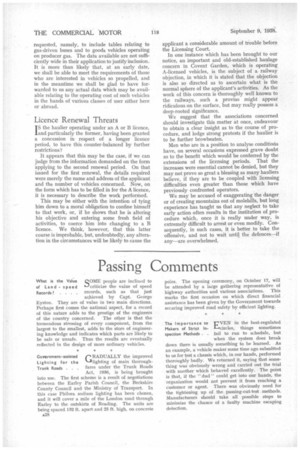Passing Comments
Page 30

Page 31

If you've noticed an error in this article please click here to report it so we can fix it.
What is the Value QOME people are inclined to of Land speed L./criticize the value of speed Records ? . records, such as that just achieved by Capt. George Eyston. They are of value in two main directions. Perhaps first comes the national aspect, for a record of this nature adds to the prestige of the engineers of the country concerned. The other is that the tremendous stressing of every component, from the largest to the smallest, adds to the store of engineering knowledge and indicates which parts are likely to be safe or unsafe. Thus the results are eventually reflected in the design of more ordinary vehicles.
Government-assisted r_RADUALLY the improved Lighting for the N.-/ilighting of main thoroughTrunk Roads . . . fares under the Trunk Roads Act, 1936, is being brought into use. The first scheme is a result of negotiations between the Earley Parish Council, the Berkshire County Council and the Ministry of Transport. In this case Philora sodium lighting has been chosen, and it will cover a mile of the London road through Earley to the outskirts of Reading. The units are being spaced 132 ft. apart and 25 ft. high, on concrete A23 poles. The opening ceremony, on October 17, will be attended by a large gathering representative of highway authorities and various associations. This marks the first occasion on which direct financial assistance has been given by the Government towards securing improved road safety by efficient lighting.
The Importance to E" ,.N in the -best-regulated
Makers of Strict Incircles, things sometimes spection Methods . . fail to run to schedule, but
when the system does break down there is usually something to be learned. As an example, a vehicle maker some time ago submitted to us for test a chassis which, in our hands, performed thoniughly badly. We returned it, saying that something was obviously wrong and carried out the trial with another which behaved excellently. The point is that, if the " dud " could get into our hands, the organization would not prevent it from reaching a customer or agent. There was obviously need for the tightening up of the passing-out-test methods. Manufacturers should take all possible steps to minimize the chance of a faulty machine escaping detection.
WITH reference to a recent VY paragraph in "One Hears," relating to horsed wagonettes running in Margate, a woman reader informs us that similar wagonettes are in use in Weymouth during the holiday period, where they ply for hire to the Upwey Wishing Well, Here would appear to be an opportunity for an enterprising coach owner. Wagonettes—But Why Not Coaches? — at Weymouth . .
WE are glad to learn that the IT Minister of Transport is again drawing the attention of highway authorities to the question of the use of unauthorized traffic signs. There are so many "legitimate " signs, already quite sufficiently confusing, and to allow any others on or near the roadway is merely adding to the difficulties of drivers. Some of the illegal signs are erected by the highway authorities themselves; others by private Growth of Illegal Road Signs to be Stopped individuals or concerns. One we noticed recently had the word " STOP " in large letters, with " for tea " in small letters underneath. As this is on a bend, it might easily cause inexperienced motorists to brake suddenly.
Protection for Our IN connection with the Oil and Fuel Re'development of homedefence measures, one of the most importaht is the sale conservation of our oil and petrol reserves. Various plans have been formulated and will be passed to the producers concerned, but C. C. Wakefield and Co., Ltd., has taken the initiative by commencing the building of protective structures around the containers it employs. These are to be formed as giant saucers, which will retain the oil in the event of the tanks being damaged. Installations we examined in France during the War had several sunken tanks in what might be termed gigantic concrete cisterns:
serves




















































































